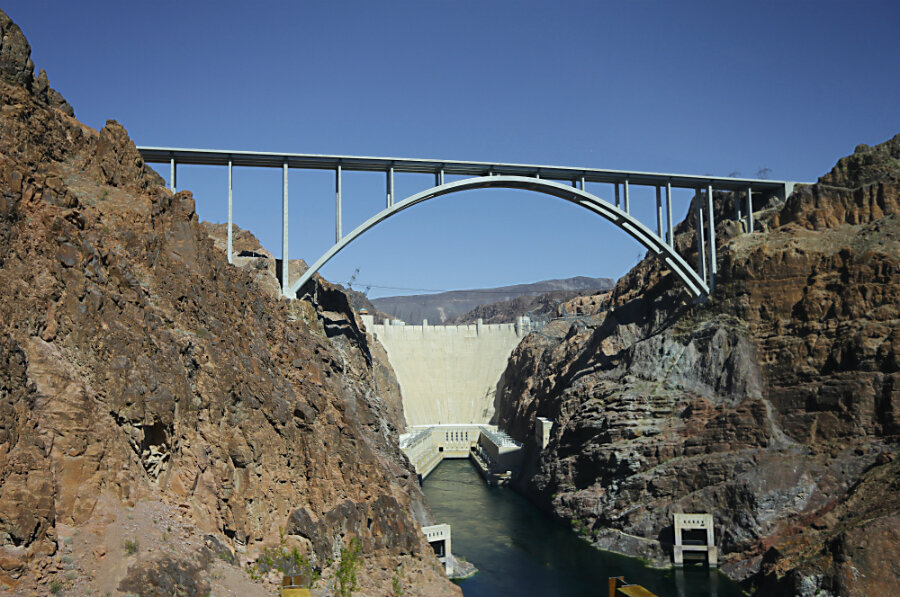Why solar panels bloom in Southwest's land of hydropower
Loading...
| Panaca, Nev.
It didn’t really matter that Kyle Donohue hadn’t built an array of solar power panels before: Lincoln County wasn’t getting the same amount of electricity from the Hoover Dam as it used to.
The lake behind the dam had dropped amid a historic drought, pushing up power costs for Lincoln County. At the same time, the community asked more about solar.
So Mr. Donohue, a staff engineer at the Lincoln County Power District that sits about 150 miles north of Las Vegas, and Dave Luttrell, the general manager, began looking into the idea.
At first blush, solar didn’t seem cheap enough to rival natural gas as an alternative to hydropower. Hiring an outside company to build the panels would be too costly.
But what if Donohue’s team built it in-house? As Mr. Luttrell penciled out the math, comparing with projected future natural gas prices, building a 1 megawatt community solar system would be cost competitive.
All they had to do was learn how to build the thing.
“It was a real learning curve – definitely – for us. But it’s not the hardest thing we’ve done out there,” says Donohue.
Now the utility is drawing some of its power from these arrays, just off a main state highway. Especially when they get full sun. “It’s a little brighter, so the minute that cloud cleared out those things kicked into full gear,” says Luttrell, surveying his new little empire of sun.
Across the West, utilities and federal officials are planning for a future with less of a mainstay energy source – hydropower – to draw on, as climate change pushes up temperatures and alters patterns of rain and snow.
Utilities like Seattle City Light and Lincoln County Power District are increasingly supplementing their hydropower with renewable electricity. Meanwhile, hydropower itself is being upgraded for a new era, as federal dam operators and users invest in wringing whatever electricity they can from rivers like the Colorado.
This shift is monumental. The federal buildout of cheap, affordable hydroelectricity through massive, ecosystem-altering public dams projects is one of the fundamental building blocks for the West, vitalizing cities and far-flung rural enclaves alike.
“The correlation between water, annual water supply and hydropower production is one of the strongest correlations out there,” says Dave Raff, science advisor with the US Bureau of Reclamation. “So any projection of changes in annual water supply is a direct reflection of generation of hydropower.”
The power grid's changing math
Today, hydropower supplies 22 percent of all electricity across 13 western states, according to the National Hydropower Association.
Utilities are increasingly adding other renewables into their mix. For power companies that own their own hydropower generation, like Seattle City Light, this makes a lot of sense: Hydropower reservoirs can act as storage systems for electricity sources like wind power, which depends on breezy conditions to generate power.
Portland General Electric, a privately owned utility in Oregon that gets 18 percent of its electricity from hydropower, isn't sure whether it will renew expiring hydropower contracts. That’s because less of it is projected to be available, and population growth has brought more demand that’s increased prices – meaning the utility may instead replace that power with renewable sources, says spokesman Steve Corson.
“They’re no longer going to be as, shall I say, spectacularly low-cost as they once were,” Corson says of federal hydropower contracts. “If we can get access to that power we won’t get as much or as at as good a price.”
In response to the challenge, hydropower users are also paying for efficiency upgrades at dams, installing turbines that can more effectively generate power with less water. A 10-percent efficiency boost could offset losses from reduced water flows, according to a January 2016 study in Nature Climate Change that studied climate change effects on 24,515 hydropower facilities worldwide.
The investments come as federally operated dams have routinely fallen short of delivering agreed-upon amounts of hydropower, a risk that buyers understood was possible. When they signed the contracts decades ago, though, they didn’t envision it being a perpetual problem.
The Colorado River Commission of Nevada, the entity in this state that bargains for federal hydropower, negotiated triggers into its next round of contracts, beginning in October. If electricity generation declines past a certain point, federal agencies will have to work to reduce costs.
Otherwise, the commission has been purchasing power – mostly natural gas – from other providers to meet customers’ needs.
“We’re going to have to find alternative sources to meet people’s loads. It won’t be met as much over the next 50 years with hydropower as it was the last 50 years. I think that’s the reality,” says Jayne Harkins, the commission’s executive director.
California is an instructive example. The state gets close to one-fifth of its electricity from hydropower, but increasingly turned to natural gas as drought hit the Golden State. Between 2011 and 2015, the state replaced lost hydropower with natural gas, costing ratepayers an extra $2 billion, according to a report by think tank the Pacific Institute.
The role of climate change
While this winter has seen big snows or rain in many parts of the West, that doesn’t shift the long-term outlook for tighter water supplies. Scientists say the region faces rising impacts from climate change.
Historically, much of the summer surface water has come from snowpack that melts as the air warms. But in a warming climate, a rising share of precipitation is falling as rain rather than snow, and snow is melting faster than before.
That’s challenged dam managers, because earlier runoff periods could cause overflows at the dams, causing major floods. But releasing water too early could leave systems depleted of water when it’s needed for agriculture, hydropower, and recreation.
The scenario of low reservoirs in summer is vexing for the Southwest, since it means less water to generate power in a season of peak demand.
The federal government has been trying to understand what climate change would mean for hydropower and other uses tied to water. Some of the projections are daunting. The Colorado River basin, for example, would see a 3 percent decline in hydropower generation for every percentage-point reduction in precipitation, according to a 2014 Government Accountability Office report. A massive report on climate change and hydropower last year predicted trouble maintaining output for nearly every Western river basin.
Hoover dam: still big, but ...
Luttrell says he is already seeing those effects. Lincoln County used to look to Hoover Dam for all its power. Now it’s about 80 percent, with natural gas filling most of the gap.
The solar project, even when fully built out in 10 years, will provide 4 percent of the utility’s capacity. That still means a great deal, though, by buffering against daily swings in customer demand, prices, and supplies from Hoover.
More utilities that rely on hydropower today are likely to look like the one Luttrell runs.
“We’ll figure out how to manage a different mix of energy systems, but we’re learning. And hydropower will be an important piece of that,” says Peter Gleick, a water expert and co-founder of the Pacific Institute.
Luttrell says he didn’t lean on climate change to convince his board that Lake Mead would be unreliable into the future. Really, he didn’t even have to.
“I don’t want to polarize a discussion I’m having with my consumers right off the bat by saying climate change or something like that,” he says. “But nobody can deny that the Colorado River has seen drought conditions since 2005. Statistically, it’s there. What the cause is, you know, I’ll leave that to other people to debate.”
Reporting for this story was supported by a fellowship at the Bill Lane Center for the American West, at Stanford University.
This is the fifth article in a series on solving water challenges in the American West.
Part 1: West's challenge is still water scarcity, wet winter or not
Part 2: In arid Southwest, cities expand but use less water
Part 3: America's biggest water users – farmers – learn to use less of it
Part 4: How water swaps help the West manage a precious resource
Part 5: Why solar panels bloom in Southwest's land of hydropower
Part 6: For water users on Colorado River, a mind-set of shared sacrifice











